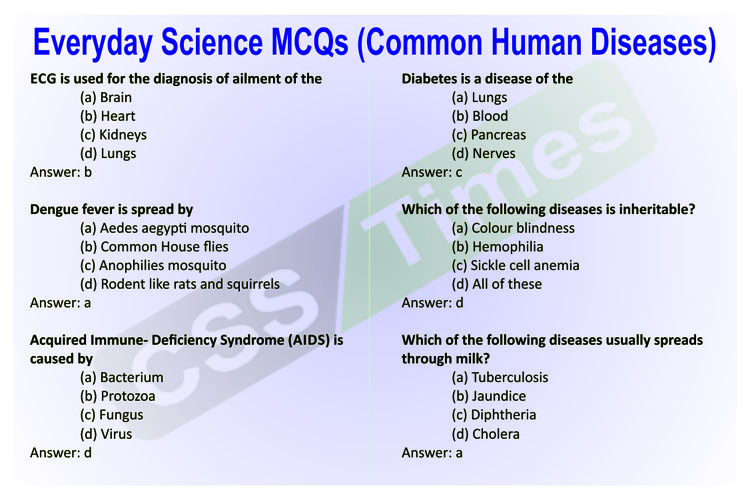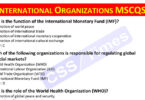ECG is used for the diagnosis of ailment of the
(a) Brain
(b) Heart
(c) Kidneys
(d) Lungs
Answer: b
Dengue fever is spread by
(a) Aedes aegypti mosquito
(b) Common House flies
(c) Anophilies mosquito
(d) Rodent like rats and squirrels
Answer: a
Acquired Immune- Deficiency Syndrome (AIDS) is caused by
(a) Bacterium
(b) Protozoa
(c) Fungus
(d) Virus
Answer: d
Check Also: Daily updated Everyday Science MCQs and Tests
Diabetes is a disease of the
(a) Lungs
(b) Blood
(c) Pancreas
(d) Nerves
Answer: c
Which of the following diseases is inheritable?
(a) Colour blindness
(b) Hemophilia
(c) Sickle cell anemia
(d) All of these
Answer: d
Read Also: CSS | Everything you need to know about CSS Exams
Which of the following diseases usually spreads through milk?
(a) Tuberculosis
(b) Jaundice
(c) Diphtheria
(d) Cholera
Answer: a
Trachoma is a disease of the
(a) Liver
(b) Eyes
(c) Lungs
(d) Kidneys
Answer: b
Which of the following is not directly related with Kawasaki disease?
(a) Lymphadenitis
(b) Fever
(c) Arthritis
(d) Conjunctiva
Answer: c
Which organ of body is affected by Typhoid?
(a) Spleen
(b) Intestine
(c) Lungs
(d) Liver
Answer: b
Which organ of body is affected by Cirrhosis?
(a) Spleen
(b) Liver
(c) Lungs
(d) Joints
Answer: b
A branch of medicine dealing with eyes and related diseases is called
(a) Ophthalmology
(b) Obstetrics
(c) Physiology
(d) Hematology
Answer: a
Read Also: Everyday Science MCQs (Vitamins) for All Competitive Exams
Pyorrhoea is a disease of the
(a) Nose
(b) Gums
(c) Heart
(d) Lungs
Answer: b
Hemophilia is known as the failure of
(a) Heart to contract
(b) Kidney to filter
(c) Stomach to digest
(d) Blood to clot
Answer: d
What part of the lungs are mainly affected by pneumonia?
(a) Alveoli
(b) Bronchioles
(c) Bronchi
(d) Pleura
Answer: a
What is the main cause of Cryptosporidiosis?
(a) Sexual activity
(b) Raw chicken
(c) Contaminated drinking water
(d) Blood
Answer: c
The polio virus enters the body through
(a) Mosquito bites
(b) Tick bites
(c) Contaminated food and water
(d) Saliva and secretion from the nose
Answer: c
Which organ is affected by Meningitis?
(a) Brain
(b) Spleen
(c) Lungs
(d) Liver
Answer: a
Whooping cough is caused by
(a) Bacillus pertussis
(b) Salmonella
(c) Variola
(d) Vibriona
Answer: a
The dreaded human disease, Syphilis, is caused by:
(a) A bacterium
(b) Fungus
(c) Animal parasite
(d) Virus
Answer: a
All of the following diseases are caused by virus except:
(a) Jaundice
(b) Influenza
(c) Typhoid
(d) Mumps
Answer: c
Check Also: Everyday Science Important Solved MCQs for Competitive Exams (Set V)
Small pox is caused by
(a) Bacteria
(b) Fungus
(c) Virus
(d) Algae
Answer: c
Measles is caused by
(a) Bacteria
(b) Fungus
(c) Virus
(d) Protozoan
Answer: c
Jaundice is caused by a/an
(a) Virus
(b) Bacteria
(c) Fungus
(d) Animal
Answer: a
What are antibodies made of?
(a) Glucose
(b) Fats
(c) Proteins
(d) None of these
Answer: c
Which of the following is not a contagious disease?
(a) Measles
(b) Hysteria
(c) Typhoid
(d) Influenza
Answer: b
Heart attack is caused due to
(a) Blood sugar
(b) cholesterol
(c) Blood urea
(d) blood protein
Answer: b
Which one of the following is a bacterial disease?
(a) Herpes
(b) Polio
(c) Pox
(d) Tetanus
Answer: d
Which of the following diseases is not caused by virus?
(a) Chickenpox
(b) Cholera
(c) Hepatitis
(d) Measles
Answer: b
Check Also: Everyday Science Important Solved MCQs for Competitive Exams (Set IV)
Convex lenses are used for the correction of:
(a) Short sightedness
(b) Astigmatism
(c) Long sightedness
(d) Cataract
Answer: c
Short sightedness can be corrected by
(a) Convex lens
(b) Concave lens
(c) Text lens
(d) None of these
Answer: b
B.C.G. vaccine is used against
(a) T.B
(b) Leprosy
(c) Food poisoning
(d) None of these
Answer: a
Which of the following is not an infectious disease?
(a) AIDS
(b) Chicken-pox
(c) Herpes Simplex
(d) Mumps
Answer: a
Diseases of which of the following pairs are caused by virus?
(a) Polio and Bird Flu
(b) Malaria and Polio
(c) Polio and Tuberculosis
(d) Tuberculosis and Influenza
Answer: a
The liver disease Hepatitis-B is caused by
(a) DNA Virus
(b) Bacterium
(c) Hepatitis B virus
(d) Platyhelminth
Answer: c
Hepatitis is a disease of
(a) Liver
(b) Kidney
(c) Thyroid
(d) Pancreas
Answer: a
Bronchitis is a disease of which of the following organs?
(a) Blood
(b) Bladder
(c) Respiratory tract
(d) Liver
Answer: c
Check Also: General Science (Everyday Science) Important Solved MCQs (Set II)
Which of the following diseases occurs due to the consumption of contaminated water?
(a) Cholera
(b) Influenza
(c) Malaria
(d) Tuberculosis
Answer: a
The most common communicable disease is
(a) Influenza
(b) Typhoid
(c) Cholera
(d) Polio
Answer: a
Which organ is affected by Pneumonia?
(a) Spleen
(b) Liver
(c) Lungs
(d) Joints
Answer: c
Tetanus is also known as
(a) Lockjaw
(b) Riboflavin
(c) Strep throat
(d) None of these
Answer: a
What part of the body does anthrax not affect?
(a) GI tract
(b) Skin
(c) Blood
(d) Lungs
Answer: c
Which one of the following is heredity disease?
(a) Polio
(b) Cholera
(c) Typhoid
(d) Hemophilia
Answer: d
H5N1 virus causing global pandemic influenza is
(a) Goat flu
(b) Bird flu
(c) Horse flu
(d) Cow flu
Answer: b
Which of the following diseases is caused by a virus?
(a) Smallpox
(b) Tuberculosis
(c) Malaria
(d) Cholera
Answer: a
Small-pox is a deadly and highly contagious
(a) bacterial disease
(b) viral disease
(c) fungal disease
(d) None of these
Answer: b
Mumps is a disease caused by
(a) Fungus
(b) Bacterium
(c) Virus
(d) None of these
Answer: c
Leukemia is a disease of the
(a) Lungs
(b) Blood
(c) Skin
(d) Nerves
Answer: b
Lack of what causes diabetes?
(a) Sugar
(b) insulin
(c) Vitamins
(d) calcium
Answer: b
Which of the following causes Malaria?
(a) Insect
(b) Bacteria
(c) Protozoa
(d) Virus
Answer: c
Ringworm is a disease caused by
(a) Fungi
(b) Virus
(c) Bacteria
(d) Genetic
Answer: a







